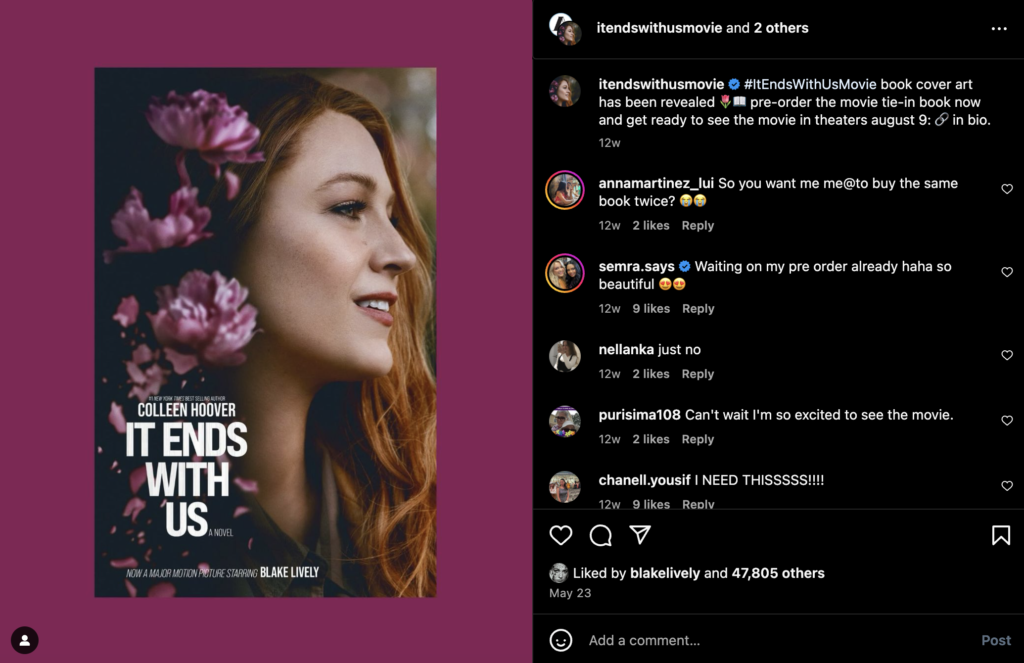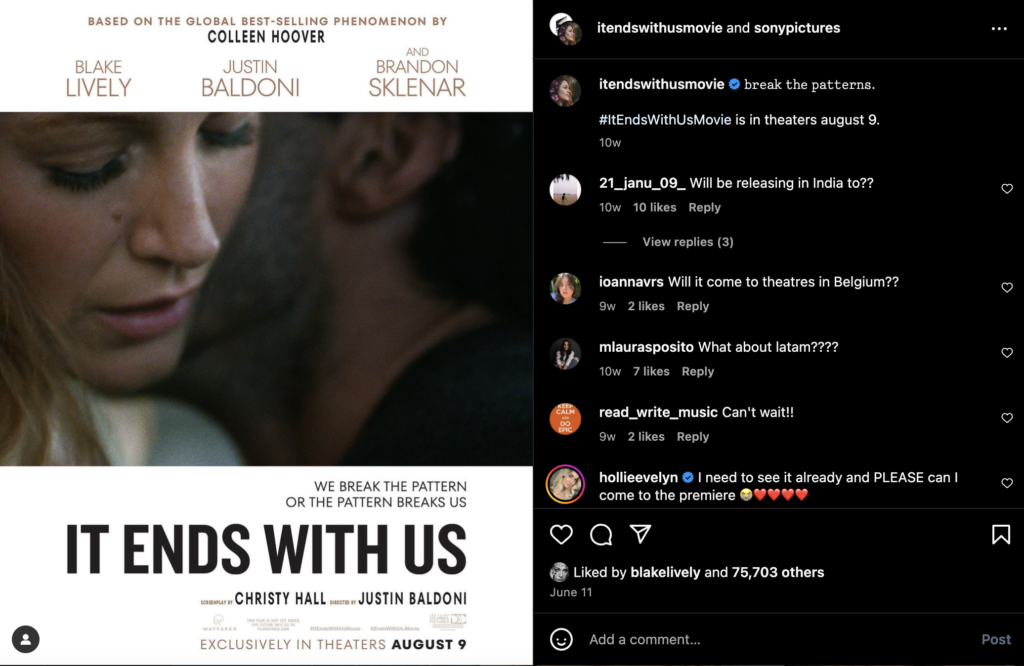Does controversy work as a marketing tool? The It Ends with Us movie has been steeped in drama ever since the casting was announced in January of last year. From casting choices and costume design to the press tour. Every move has been met with intense scrutiny, often leading to a backlash that had to be quickly addressed. Here’s a recap of all the controversies leading up to its release earlier this month.
The Casting Conundrum
One of the most talked-about aspects of the movie’s was the announcement of Blake Lively and Justin Baldoni in the lead roles. Fans of Colleen Hoover’s novel were eager to see how their beloved characters, Lily Bloom and Ryle Kincaid, would be brought to life on screen. However, when it was revealed that Lively (36) and Baldoni (39) would play these roles, the internet erupted in debate.
Fans argued that the characters in the book are in their early to mid-20s, and casting actors significantly older broke the immersion of the story. This misalignment led to a wave of disappointment and criticism on social media. The marketing team had to pivot quickly, with Colleen Hoover herself stepping in to explain the decision. Hoover clarified that the characters were intentionally aged up to make the story more realistic—particularly because a neurosurgeon in his twenties, like Ryle, wouldn’t be plausible. This explanation, though logical, didn’t fully quell the uproar, leaving a divide between the die-hard fans and the filmmakers.
Costume Controversy
The drama didn’t stop at casting; it spilled over into the costume design as well. Blake Lively’s on-set outfits were another hot topic, with fans criticising the choice of clothing as being out of touch with the character’s persona. In the book, Lily Bloom is portrayed as a young, trendy florist, but the costumes in the movie were labeled as “outdated” and not reflective of her vibrant personality.
The creative team, which had initially highlighted the film’s fashion choices in promotional materials, found themselves in damage control mode. They had to shift the narrative from focusing on the aesthetics to emphasising the story’s emotional depth and the actors’ performances, which they hoped would resonate more with the audience.
Unfortunately, these marketing efforts were ultimately rendered ineffective,
Social Media Backlash
The online backlash was immediate and fierce, particularly on platforms like Twitter and TikTok, where the primary demographic for the film are most active. Memes, critical videos, and long threads dissecting the marketing missteps flooded social media. The hashtags #ItEndsWithUs and #BlakeLively trended for days, but not for the reasons the creators had hoped.
In response, the marketing team began rolling out behind-the-scenes content, interviews with the cast and crew, and more direct engagement with fans. They hoped that by providing more context and showing the thought process behind the decisions, they could win back the audience’s trust. However, the damage was done, and the campaign’s effectiveness was notably dampened by the controversies.
The release of the It Ends With Us movie has been overshadowed by significant marketing drama, from the get-go. Pre-debut the drama shifted involving a potential fued between its lead actors, Blake Lively and Justin Baldoni. The film, adapted from Colleen Hoover’s bestselling novel, has faced heavy criticism from fans and media alike, not just for its casting choices, but for the stark differences in how its stars have promoted the movie.
Blake Lively and Justin Baldoni Feud: What’s Going On?
Rumours of tension between Blake Lively and Justin Baldoni began circulating shortly after the first promotional material for the movie was released. Fans noticed that the two actors were rarely seen promoting the film together, leading to speculation that there might be bad blood between them. While neither Lively nor Baldoni have publicly addressed these rumours, the discrepancy in their promotional strategies has only added fuel to the fire.
Fans Criticise Promotional Differences
The disparity in how Lively and Baldoni have promoted It Ends With Us has not gone unnoticed by the film’s fanbase. Blake Lively, known for her strong personal brand, has taken an unconventional approach by incorporating her own products into the film’s promotion. This includes wearing outfits from her own fashion line in press interviews and using her Instagram to subtly market her brand alongside the movie. While some fans see this as savvy self-promotion, others have criticised Lively for what they perceive as a lack of focus on the movie itself.
On the other hand, Justin Baldoni has taken a more traditional route, focusing on the film’s themes and his role as both actor and director. His promotional content has emphasised the movie’s storyline, the importance of its message, and the challenges of bringing such a beloved book to the big screen. This contrast has led to discussions on social media, with fans questioning why the two stars seem to be on such different pages when it comes to marketing.
The Blake Lively Controversy: Promoting Her Own Products
One of the most talked-about aspects of Blake Lively’s involvement in the film’s promotion has been her apparent prioritisation of her own business ventures over the movie itself. Lively, who is both a fashion icon and an entrepreneur, has been accused of using the film’s promotional tour as a platform to push her own brand. This move has not only irked some fans but has also drawn criticism from industry insiders who believe it distracts from the movie’s core marketing campaign.
Blake Lively tried to promote the movie “It Ends With Us” by tying it in with her new haircare line, which sparked significant backlash. Critics argued that this approach was tone-deaf given the film’s serious themes surrounding domestic violence. Additionally, fans online also noted that Lively had not acknowledged the film’s domestic violence theme, yet described the film as “fun,” “summery,” and “cutesy,” which clashed with the movie’s intended message of raising awareness about domestic abuse. Another comment that upset fans online was a promotional video after the film’s release, Blake said, “It Ends With Us is in theatres now, so grab your friends, wear your florals, and head out to see it.” This marketing strategy was widely criticised as being “tone-deaf” and for downplaying the gravity of the film’s subject matter, leading to concerns that it disrespected the experiences of those affected by domestic violence.
Further criticism sparked when Lively promoted her alcoholic beverage company ‘Betty Buzz’, at an ‘it ends with us’ event. At an after-party for the It Ends With Us premiere, Blake Lively chose to promote her beverage company by hosting a themed event focused on alcohol, with cocktails named after elements of the film. Some of the drink names included ‘Blooming Betty’, ‘Tom Colleen’s’, ‘It ends with buzz’, and the controversial ‘Ryle You Wait’ – named after the film’s antagonist. This particular cocktail drew criticism, with people saying, ““Did they really create a cute cocktail name after Ryle, the actual abuser in the story? ”Wow, it’s real. They really named a cocktail after an abusive character.” This event became the breaking point for much of the backlash from Lively’s supporters.

Find the original instagram menu post here
How has Justin Baldoni responded to the Backlash?
Justin Baldoni, who both stars in and directs It Ends With Us, has taken a markedly different approach from Blake Lively in promoting the film. While Lively’s promotional efforts have been criticised for being tone-deaf, Baldoni has focused on the film’s core themes of domestic violence. He has actively engaged in conversations about the importance of these themes and has partnered with organisations like “No More,” which works to end domestic and sexual violence, to ensure the film’s portrayal of these issues is both realistic and respectful.
Baldoni has also openly addressed the importance of representing domestic violence accurately in the film. In interviews, he has emphasized that the movie is not just entertainment but also a vehicle for sparking meaningful discussions about domestic violence and the effects it has on individuals and families. His approach has been praised for its sensitivity and alignment with the film’s serious subject matter.
This contrast between Baldoni’s and Lively’s promotional strategies has only fuelled rumours of a rift between the two stars, with fans noting the stark differences in how they have each chosen to represent the movie. Baldoni’s focus on the film’s message stands in sharp contrast to Lively’s more commercial approach, leading to a significant public conversation about how serious topics should be marketed in Hollywood.
The Impact on the Movie’s Reception
The ongoing drama between Lively and Baldoni, coupled with the controversy over how the movie is being promoted, has undoubtedly impacted the film’s reception. Fans of the book, already divided over the casting choices, are further split over the marketing strategies employed by the film’s stars. The tension and inconsistency in promotion have led to a disjointed campaign that fails to capture the cohesive spirit that fans were hoping for.
Even the Film Posters Sparked Controversy Online
Amid the rumors of a feud between Lively and Baldoni, fans noticed that the movie’s original poster had been replaced, causing quite a stir. The original poster, which many believe was creatively directed by Baldoni, featured a striking image of the two lead characters, Lily and Ryle, alongside the tagline “We break the pattern or the pattern breaks us.” Many fans felt this version best represented the film. A deeper look into the movie’s original Instagram page reveals that this poster was shared in June 2023, further supporting the claim that it was the intended design.
In contrast, the current poster, now in use, features only Lively’s character, Lily, with the tagline “We love, we break, we pick up the pieces.” Fans have criticized this change, arguing that it’s weaker than the first and questioning why it only showcases Lively’s character. This shift has further fueled speculation about the rumored feud and creative differences. Interestingly, the film’s current poster was initially revealed last May as cover art for the book.
Here are the two posters from the film’s original Instagram page:
The current movie poster:

https://www.instagram.com/p/C7Sh-o9P3AL
The original movie poster:

The Cross-Promotion with Deadpool and the “Barbenheimer” Comparison
Adding another layer to the drama, many accuse the marketing team for attempting to replicate the success of the “Barbenheimer” phenomenon—a term that emerged from the simultaneous release of Barbie and Oppenheimer by cross-promoting It Ends With Us with Deadpool 3. This move was particularly curious given that Deadpool is known for its irreverent, comedic tone, which contrasts sharply with the serious themes of It Ends With Us.
The comparison to “Barbenheimer” fell flat for many, with critics arguing that the tonal dissonance between the two films made the marketing ploy feel forced and inauthentic. Instead of generating excitement, the cross-promotion was met with confusion and even mockery online, leading some to label it as a marketing flop.
However, was it really a failure? Despite the criticism, the controversy surrounding Lively’s self-promotion and the unusual marketing tactics have kept It Ends With Us in the spotlight. The conversation has dominated social media, particularly on platforms like Twitter and TikTok, where the target demographic are most active. The backlash, debates, and memes have ensured that the movie remains a trending topic, turning what could have been a misstep into a potentially successful strategy.
Controversy as a Marketing Tool?
While traditional marketing wisdom might suggest that controversy is best avoided, the It Ends With Us campaign suggests otherwise. The nonstop discussion about Blake Lively’s promotional choices and the movie’s unconventional marketing tactics have ensured that the film stays in the public consciousness. For two weeks, it’s been all anyone can talk about, proving that in the world of modern marketing, even a “flop” can have its benefits.
The true testis, how the buzz translates into box office success. According to Cosmopolitan, the film has garnered a success of over $100 million at the box office. Despite all the drama, the film still managed to be a huge success.
One thing’s for sure— It Ends With Us marketing has managed to capture the internet’s attention, for better or worse.

